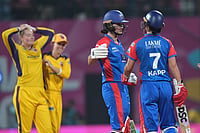Form is a fickle thing. Great performers know how to deal with this, so their performances—on the sports field, on stage, in music or on the podium—don’t fall below a certain level. Writers and artists who do their stuff behind closed doors either tend to keep at it till they find their touch again or lay off for a while in the hope of doing so soon.
Aspects of form and the loss of it apply to every area of life that calls for skill and freedom, wrote psychoanalyst, philosopher and former England cricket captain Mike Brearley, in his exploration of the concept in the wonderful On Form.
When critics say, “the performance lacked soul” or insist that there was nothing technically wrong with a performance but it somehow didn’t come together, they are pointing to the existence of the opposite of being out of form—being in the ‘zone’. Hungarian psychologist Mihaly Csikszentmihalyi (pronounced: Me high. Cheeks send me high) has written on the state of consciousness called ‘flow’, which is like being in the zone that sportsmen speak of.
ALSO READ: Form Is A Mental Thing: Gautam Gambhir
Here’s Pele on his performance in the 1958 World Cup final against Sweden: “I felt a strange calmness; it was a type of euphoria. I felt I could run all day without tiring, that I could dribble through any of their team or all of them, that I could pass through them physically. It was a feeling of invincibility.”
The poet Yeats put it thus: “…so great my happiness/That I was blessed, and could bless.” A state of grace then, or bliss.

Although much has been written about the zone or state of flow where things come together miraculously, the opposite condition—the sudden or sustained loss of form—has not been dealt with in quite the same manner. The attic of consciousness is somehow better understood in this case than the basement. In both, there is something unexplained, causes are mysterious, but the effects are clear and in public view.
How does a performer suddenly lose his magic and spend time trying to remember the abracadabra to the kind of performance that was second nature to him? How do you realign the mind, body and spirit to rediscover what seemed natural till recently? The curious thing about the flow is that the moment you think you have it, you get self-conscious and lose it.
The writer and teacher Jonathan Smith wrote, “As a classroom teacher for 40 years, how could it be that I was teaching well one day and badly the next? In tune one minute, edgy the next? Optimistic one term, low and deflated another? How can one hold on to what is good and what works?” Which professional, from sportsman to accountant, hasn’t felt that?
Sometimes, you can lose form in the course of a performance and rediscover it while continuing to play. Sometimes form keeps away for so long that your career is over before it has a chance of resurrection. Loss of form is accompanied by anxiety, fear and the conviction that perhaps the good times, the centuries, the goals, the ability to hit the lines consistently were all a chimera, a fantasy that never existed. When form deserts you, however briefly, bad luck often takes its place.
“As writers or artists, we stick with the empty page or canvas in front of us, the anxiety inside us. We keep at it, revising or painting over the poor stuff we turn out, believing (or hoping) that in the end, something worthwhile will appear,” wrote Brearley. It can occur in mid-career too, and the solution varies from breaking away temporarily to focussing harder. There is no one-size-fits-all answer.
Only the mediocre are always at their best. The greats have ups and downs but know how to make the ups last and disguise the downs. All performances take place somewhere along the continuum from being in form to losing it to being in the zone. The order might change, the time spent in each category might vary, with the zone often being momentary (taking a brilliant catch, for example) and the other two temporary by definition.
India’s greatest batsmen Sunil Gavaskar and Sachin Tendulkar have suffered loss of form and with it, the inevitable drop in confidence, and have had to deal with cries for their head. Now the next beacon, Virat Kohli, is going through a similar phase. Physically, he doesn’t appear to be struggling, but as it often happens when you are out of form, the first mistake you make tends to be your last. You are wracked with self-doubt. And you ask the dreaded question: Is this terminal?
In your anxiety to score runs, you tend to play at every ball, your grip on the bat handle tends to get tighter, you overcompensate, the feet don’t move with the ease and naturalness it did before. You are caught in a spiral. From loss of form, finding your way to the zone, a journey from the prosaic to the poetic can be excruciating. It is not made easier by fans and critics who can be every bit as fickle as form itself.
Ironically, cricket, a thinking man’s game, demands at this stage that you don’t think too much, that you go with the flow (no coach would recommend that!), and create a mood where one innings, one stroke or one moment can overturn everything and find the form that got you this far: in Kohli’s case 23,726 runs from 463 international matches and 70 centuries.

His bad patch has lasted two-and-a-half years. Yet, even in this dark phase, as I have pointed out elsewhere, he has scored over 2,500 runs in 79 innings across formats with an average of 35.5, which is just under Chris Gayle’s career average and higher than that of Sanath Jayasuriya, Yuvraj Singh and Jos Buttler.
That we demand more from Kohli is as much a tribute to his batsmanship as to our hunger for statistical neatness. This is the tyranny of expectation.
Asked during the IPL about what audiences don’t see about him, Kohli replied: “It’s the moment when you are sitting in your room with absolutely zero confidence, with absolutely zero conviction that you can perform the next day, and what it takes to overcome that.” Superstars are human too.
How a sportsman overcomes loss of form says more about him than statistics, anecdotes or analysis. Some make slight technical adjustments, others do mental exercises to reconnect with their best days, some do nothing, calculating that it is only a matter of time before things get back to normal, others get into a mess following too much advice. But just as it is not always clear what caused the loss of form in the first place, so it is with how it can be willed back.
Loss of form, by whatever name you call it, can be universal. But is there something about cricket itself that provokes it? The late Peter Roebuck wrote, “It’s strange that cricket attracts so many insecure men. It is surely the very worst game for an intense character, yet it continues to find many obtuse sensitivities among its players. Men of imagination, men of ideals risk its hard exposures.” Roebuck, himself an average batsman but an outstanding thinker on the game and respected captain, best exemplified this. He risked its hard exposures and ended by taking his own life.
“Wouldn’t it be marvellous,” Geoff Dyer writes in his latest work, The Last Days of Roger Federer and Other Endings, “if it were possible to be a serious writer without taking oneself at all seriously?” Then he clarifies: “I mean, while actually doing the work.”
This is an echo of Greg Chappell’s insight that a batsman “needs to get away from thinking about technique or any of the things that interfere with watching the ball and just respond to what he sees. The conscious mind must be kept occupied so as not to interfere with the subconscious mind doing its job.” To be a serious batsman without taking everything too seriously, in other words. Easier said than done, of course.
Of the various bits that make up the sporting quilt it is the comeback that is in the brightest colours. On field, during the game or off field, returning from injury or loss of form. The boxer Muhammad Ali came back once too often, though, and ended his career beaten by the Jamaican-Canadian Trevor Berbick, 12 years his junior. It was, wrote Hugh McIlvanney, “like watching a prince leave town on the back of a dustcart.”
Kohli is caught in a vice between conscious control and spontaneity, and it gets tighter with every (relative) failure. His own strong self-belief and determination might be working against him now. He needs to let go—and that is difficult for any performer, especially one struggling to find form—but he has the determination to ease up on the determination. To not overthink it. A prince can’t be allowed to leave in a dustcart.
(This appeared in the print edition as "End of an Affair?")
(Views expressed are personal)
Suresh Menon is a sports columnist

























